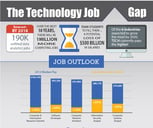 For better or worse, we are about the enter the age of smart everything. Whatever you think of that proposition, the fact is that sensors, the tiny devices that fuel the Internet of Things are getting smaller and cheaper all the time. As they do, we will start to see them transmitting data from some highly unlikely intelligent devices, while tracking everything from road conditions to building health to cars to industrial equipment. The Internet of Things is a term that’s being bandied about with increasing frequency these days. You could think of it as the “cloud” of 2015 — that buzzword that marketers put in absolutely everything because it makes their company sound cool and hip.
For better or worse, we are about the enter the age of smart everything. Whatever you think of that proposition, the fact is that sensors, the tiny devices that fuel the Internet of Things are getting smaller and cheaper all the time. As they do, we will start to see them transmitting data from some highly unlikely intelligent devices, while tracking everything from road conditions to building health to cars to industrial equipment. The Internet of Things is a term that’s being bandied about with increasing frequency these days. You could think of it as the “cloud” of 2015 — that buzzword that marketers put in absolutely everything because it makes their company sound cool and hip.The Internet of Things in actuality involves a network of smart sensors collecting data. As the sensors grow ever cheaper, and the network grows ever larger, the more data we can collect to make ever more intelligent decisions (at least in theory).
On The Edge Of A Major Shift
Nils Herzberg, global co-lead for IoT at SAP says the beauty of sensors that they bring real-time data to applications. “Customers run applications for business critical processes, which could run better with real-time awareness,” Herzberg said. He says when sensors provide real-time information, customers can make better decisions, rather than using guess work.The reason why we’re seeing more talk about the Internet of Things is the diminishing size and cost of sensor technologies, says James Bailey, managing director of the mobility practice at Accenture.
“Our perspective is that cost of both the sensors and devices is approaching free and the size is approaching invisible. Our perspective is literally everything will have IOT technology at some point,” - James Bailey, Accenture
Bailey believes that we are not there yet, but as these devices get smaller and cheaper, the technology will become ubiquitous. “The key thing is understanding the value proposition being provided the different economic parties [involved],” he explained.
What he means that the same sensor data may used differently, depending on the industry. “It’s driven by the business case,” he said. “If there is a use case driving tremendous value, we would see more of a transformational project.”
Making Use Of The Data
But once we collect the data, we have to do something. We have to use it to take actions to improve our business processes, or it doesn’t really help us at all.Sensors can feed a company data to make highly inefficient processes much more efficient, but SAP’s Herzberg says the proliferation of that data has become so massive that companies are overwhelmed and humans can’t keep up with it.
Then software takes over the task of finding correlation, and a step beyond that companies may turn to prediction capabilities that will tune themselves. That evolution takes a certain critical mass of sensors in the network and software that can begin to make better use of the data the sensors are collecting.
For now, he says SAP is one of a number of companies including IBM, Microsoft and countless startups working on making better predictions. As Herzberg says, once you have been able to collect the data from a sensors, you can begin to build increasingly complex sets of predictions.
SAP is working with the Port of Hamburg to help reduce traffic congestion around the port. It found that 70 percent of trucks arrive too early, whether the ship is ready to receive the cargo or not. Sensors could let the system know a ship hadn’t docked yet, and communicate this to truckers before they drive into the port area. This could reduce congestion and pollution around the port.
Moving To Smart Everything
Sensors are not just the domain of industry though. Our phones are full of sensors from the GPS to the accelerometer to the compass, all of them feeding data to apps and to the cloud. So are our watches, like the Apple Watch.
Humanyze, a new startup that has created a smart employee badge to help track employee movements and social interactions throughout the day and correlate the data to company goals.
As I wrote about the badge, “They developed a smart employee badge with a microphone, accelerometer, bluetooth connection and other tools typically found in a smart phone.”
If you want further proof that we are entering the age of smart everything, consider that Oral B has a smart toothbrush. The toothbrush uses Bluetooth and a mobile app to capture data about your tooth brushing habits. It includes a timer to make sure you’re brushing for a full two minutes, and it maps your brushing so if you concentrate really hard on your bottom front and give short shrift to your upper molars, the app lets you know and gives you feedback.
You can even share your toothbrushing data with your dentist or hygienist and an Oral B spokesperson told me me at an event at Mobile World Congress last week, that you own your toothbrushing data, so you’re not even sharing it with the company.
If that doesn’t strike your fancy, how about the Johnny Walker smart scotch bottle that protects the product along the supply chain ensuring that nobody has opened it along the journey — or how about a smart car? For example, there is a Volvo that uses sensors to detect black ice and transmits data to the cloud, where it can warn other drivers coming down the same road about the impending danger.
There are companies using sensors to track shipments; to warn when perishables in warehouses might be going bad; that tell you when a piece of equipment is about to fail; when to heat or cool our houses or office buildings; track school busses — and use cases we probably haven’t even imagined.
These sensors will add information to an ever-growing network of connected devices producing mountains of data. The trick will be harnessing all of this information instead of drowning in it. But if you consider what Tim O’Reilly once said, “The guy with the most data wins,” then we’re about to make the race a whole lot more interesting.
This is where Alpha Software comes in - rapidly allowing you to build systems to manage, harness and act on this data - exciting stuff!







Comment